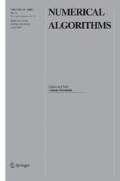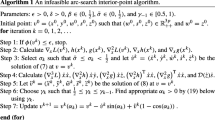Abstract
We present an arc-search infeasible interior-point algorithm for semidefinite optimization using the Nesterov-Todd search directions. The algorithm is based on the negative infinity neighborhood of the central path. The algorithm searches an ε-approximate solution of the problem along the ellipsoidal approximation of the entire central path. The convergence analysis of the algorithm is presented and shows that the algorithm has the iteration complexity bound \(\mathcal {O}\big (n^{3/2}\log {\varepsilon }^{-1}\big )\). Here, n is the dimension of the problem and ε is the required precision. The numerical results show that our algorithm is efficient and promising.

Similar content being viewed by others
References
Ai, W., Zhang, S.: An \(o(\sqrt {n}L)\) iteration primal-dual path-following method, based on wide neighborhoods and large updates, for monotone LCP. SAIM J. Optim. 16(2), 400–417 (2005)
Alizadeh, F.: Combinatorial optimizationwith interior-point methods and semi-definite matrices. Ph.D.thesis, Computer Science Department, University of Minnesota Minneapolis (1991)
Alizadeh, F.: Interior point methods in semidefinite programming with applications to combinatorial optimization. SIAM J. Optim. 5(1), 13–51 (1995)
Borchers, B.: Sdplib 1.2, a library of semidefinite programming test problems. Optim. Methods Softw. 11, 683–690 (1999)
Boyd, S. E., Ghaoui, L.El., Feron, E., Balakrishnan, V.: Linear Matrix Inequalities in System and Control Theory. SIAM studies in Applied Mathematics, SIAM, Philadelphia (1994)
de Klerk, E.: Aspects of Semidefinite Programming. Kluwer Academic, Dordrecht (2002)
Dolan, E. D., Moré, J.J.: Benchmarking optimization software with performance profiles. Math. Program. 91(2), 201–213 (2002)
Halicka, M., de Klerk, E., Roos, C.: On the convergence of the central path in semidefinite optimization. SIAM J. Optim. 12(4), 1090–1099 (2002)
Helmberg, C., Rendl, F., Vanderbei, R., Wolkowicz, H.: An interiorpoint method for semidefinite programming. SIAM J. Optim. 6(2), 342–361 (1996)
Jansen, B., Roos, C., Terlaky, T.: Improved complexity using higher-order correctors for primal-dual Dikin affine scaling. Math. Program. 76(1), 117–130 (1997)
Kheirfam, B.: An arc-search interior point method in the \(N^{-}_{\infty }\) neighborhood for symmetric optimization. Fundam. Inform. 146(3), 255–269 (2016)
Kheirfam, B.: An arc-search infeasible interior point algorithm for HLCP in the \(\mathcal {N}^{-}_{\infty }\) neighborhood of the central path. Int. J. Comput. Math. 94(12), 2271–2282 (2017)
Kheirfam, B., Moslemi, M.: On the extend of an arc-search interior-point algorithm for semidefinite optimization. Numer. Algebra Control Optim. 8(2), 261–275 (2018)
Kojima, M., Shindoh, S., Hara, S.: Interior-pointmethods for the monotone semidefinite linear complementarity problem in symmetric matrices. SIAM J. Optim. 7(1), 86–125 (1997)
Lasserre, J. B.: Globle optimization with polynomials and the problems of moments. SIAM J. Optim. 11(3), 796–817 (2001)
Mehrotra, S.: On the implementation of a primal-dual interior point method. SIAM J. Optim. 2(4), 575–601 (1992)
Monteiro, R. D. C.: Primal-dual path-following algorithms for semidefenite programming. SIAM J. Optim. 7(3), 663–678 (1997)
Monteiro, R. D. C.: Polynomial convergence of primal-dual algorithms for semidefnite programming based on Monteiro and Zhang family of directions. SIAM J. Optim. 8(3), 797–812 (1998)
Monteiro, R. D. C.: First- and second-order methods for semidefnite programming. Math. Program. 97(12), 209–244 (2003)
Monteiro, R. D. C., Zhang, Y.: A unified analysis for a class of long-step primal-dual path-following interior-point algorithms for semidefinite programming. Math. Program. 81(3), 281–299 (1998)
Nesterov, Y. E., Nemirovsk, A. S.: Interior point methods in convex programming: theory and applications. SIAM, Philadelphia (1994)
Nesterov, Y. E., Todd, M. J.: Self-scaled barriers and interior-point methods for convex programming. Math. Oper. Res. 22(1), 1–42 (1997)
Nesterov, Y. E., Todd, M. J.: Primal-dual interior-point methods for self-scaled cones. SIAM J. Optim. 8(2), 324–364 (1998)
Toh, K. C., Todd, M. J., Tutuncu, R. H.: SDPT3–A Matlab software package for semidefinite programming. Optim. Methods Softw. 11, 545–581 (1999)
Wang, W., Liu, H., Bi, H.: A modified infeasible interior-point algorithm with full-Newton step for semidefinite optimization. Int. J. Comput. Math. 96(10), 1979–1992 (2018)
Parrilo, P. A.: Semidefinite optimization relaxations for semialgebraic problems. Math. Program. 96(2), 293–320 (2003)
Yamashita, M., Fujisawa, K., Fukuda, M., Kobayashi, K., Nakata, K., Nakata, M.: Latest developments in the SDPA family for solving large-scale SDPs. In: Handbook on semidefinite, conic and polynomial optimization, pp. 687–713 (2012)
Yang, Y.: A polynomial arc-search interior-point algorithm for convex quadratic programming. Eur. J. Oper. Res. 215(1), 25–38 (2011)
Yang, Y.: A polynomial arc-search interior-point algorithm for linear programming. J. Optim. Theory Appl. 158(3), 859–873 (2013)
Yang, Y.: Two computationally efficient polynomial-iteration infeasible interior-point algorithms for linear programming. Numer. Algorithm. 79(3), 957–992 (2018)
Yang, X., Zhang, Y., Liu, H.: A wide neighborhood infeasible-interior-point method with arc-search for linear programming. J. Appl. Math. Comput. 51, 209–225 (2016)
Yang, X., Liu, H., Zhang, Y.: An arc-search infeasible-interior-point method for symmetric optimization in a wide neighborhood of the central path. Optim. Lett. 11, 135–152 (2017)
Zhang, Y.: On extending some primal-dual interior-point algorithms from linear programming to semidefinite programming. SIAM J. Optim. 8, 365–386 (1998)
Zhang, M., Yuan, B., Zhou, Y., Luo, X., Huang, Z.h.: A primal-dual interior-point algorithm with arc-search for semidefinite programming. Optim. Lett. 13(5), 1157–1175 (2019)
Acknowledgments
We are grateful to the anonymous referees and editor for their useful comments that help us improve the presentation of this paper.
Author information
Authors and Affiliations
Corresponding author
Additional information
Publisher’s note
Springer Nature remains neutral with regard to jurisdictional claims in published maps and institutional affiliations.
Appendix
Appendix
In this section, we describe the details of the test problems in Section 4 [24].
-
1.
Max-cut problem (Mc):
$$ \begin{array}{@{}rcl@{}} \begin{array}{ccc} & \multicolumn{2}{l}{ \min~\text{Tr}(LX )} \\ \qquad \qquad&& s.t.~~ \text{diag}(X)=\frac{e}{4} \quad\\ \qquad \qquad\qquad&& X\succeq 0, \quad \end{array} \end{array} $$where L = B −Diag(Be) and B is the weighted adjacency matrix of a graph [9] and e is a vector of all ones.
-
2.
Norm-min problem (NM):
$$ \min_{x\in\mathbb{R}^{m}} \big\|B_{0}+x_{1}B_{1}+\cdots+x_{m}B_{m}\big\|_{2}, $$where Bk, for k = 0, 1,⋯ ,m is an p × q matrix. For this problem, we consider p = q = n and randomly generate the matrices as Bk = rand(n) for k = 0, 1,⋯ ,m.
-
3.
Control problem(C):
$$ \begin{array}{@{}rcl@{}} \begin{array}{ccc} & \multicolumn{2}{l}{ \max_{(P,t)} t} \\ \qquad \qquad&& s.t.~ -\text{Tr}((B_{k})^{T} P)-\text{Tr}(P(B_{k}))\succeq 0\quad k=1, \cdots, L \\ \qquad \qquad&& I-P\succeq 0, \ P-tI\succeq 0,\ P=P^{T},~~~~~~~ \end{array} \end{array} $$where Bk, for k = 0, 1,⋯ ,L, are the square real matrices n dimension. For this problem, we generate the matrices as Bk = rand(n), for k = 0, 1,⋯ ,m.
-
4.
Graph partitioning problem (Gp):
$$ \begin{array}{ccc} & \multicolumn{2}{l}{ \min~\text{Tr}(CX)} \\ \qquad \qquad&& s.t.~\text{Tr}((ee^{T})X)=1~~~~~~~~~~~~~~~~ \\ \qquad \qquad&& X_{ii}=1\quad i=1, \cdots, n. \end{array} $$where C = −(diag(Be) − B) and B is the weighted adjacency matrix of a graph with n nodes [9] and e is a vector of all ones.
-
5.
Lovasz theta number problem (Ltn):
$$ \begin{array}{ccc} & \multicolumn{2}{l}{\min~\text{Tr}(CX)} \\ \qquad \qquad&& s.t.~\text{Tr}(X)=1~~~~~~~~~~~~~~~~~~~~~ \\ \qquad \qquad&& ~~~~ \text{Tr}(A_{ij}X)=0\quad (i, j)\in E\\ \qquad \qquad&& X\succeq 0. \end{array} $$where:
-
C is a matrix of all minus ones.
-
B is the adjacency matrix of the given graph [9].
-
E is the set of edges of the given graph.
-
\(A_{ij}=(e_{i}{e_{j}^{T}}+e_{j}{e_{i}^{T}})/\sqrt {2}\).
-
ei denotes the i th column of B.
-
Rights and permissions
About this article
Cite this article
Kheirfam, B., Osmanpour, N. & Keyanpour, M. An arc-search infeasible interior-point method for semidefinite optimization with the negative infinity neighborhood. Numer Algor 88, 143–163 (2021). https://doi.org/10.1007/s11075-020-01033-1
Received:
Accepted:
Published:
Issue Date:
DOI: https://doi.org/10.1007/s11075-020-01033-1



